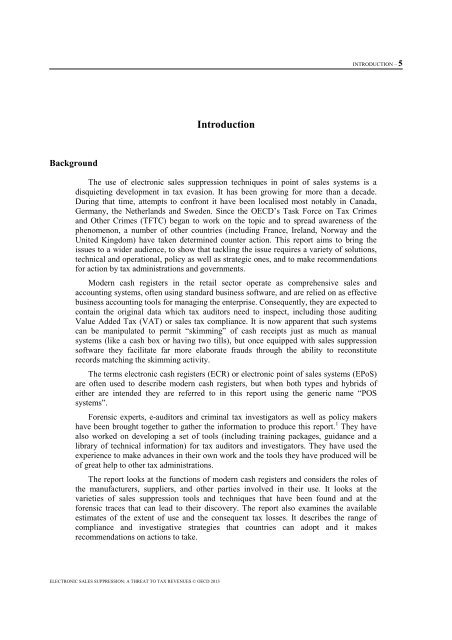ELECTRONIC SALES SUPPRESSION: A THREAT TO TAX REVENUES
ELECTRONIC SALES SUPPRESSION: A THREAT TO TAX REVENUES
ELECTRONIC SALES SUPPRESSION: A THREAT TO TAX REVENUES
You also want an ePaper? Increase the reach of your titles
YUMPU automatically turns print PDFs into web optimized ePapers that Google loves.
Background<br />
<strong>ELECTRONIC</strong> <strong>SALES</strong> <strong>SUPPRESSION</strong>: A <strong>THREAT</strong> <strong>TO</strong> <strong>TAX</strong> <strong>REVENUES</strong> © OECD 2013<br />
Introduction<br />
INTRODUCTION – 5<br />
The use of electronic sales suppression techniques in point of sales systems is a<br />
disquieting development in tax evasion. It has been growing for more than a decade.<br />
During that time, attempts to confront it have been localised most notably in Canada,<br />
Germany, the Netherlands and Sweden. Since the OECD’s Task Force on Tax Crimes<br />
and Other Crimes (TFTC) began to work on the topic and to spread awareness of the<br />
phenomenon, a number of other countries (including France, Ireland, Norway and the<br />
United Kingdom) have taken determined counter action. This report aims to bring the<br />
issues to a wider audience, to show that tackling the issue requires a variety of solutions,<br />
technical and operational, policy as well as strategic ones, and to make recommendations<br />
for action by tax administrations and governments.<br />
Modern cash registers in the retail sector operate as comprehensive sales and<br />
accounting systems, often using standard business software, and are relied on as effective<br />
business accounting tools for managing the enterprise. Consequently, they are expected to<br />
contain the original data which tax auditors need to inspect, including those auditing<br />
Value Added Tax (VAT) or sales tax compliance. It is now apparent that such systems<br />
can be manipulated to permit “skimming” of cash receipts just as much as manual<br />
systems (like a cash box or having two tills), but once equipped with sales suppression<br />
software they facilitate far more elaborate frauds through the ability to reconstitute<br />
records matching the skimming activity.<br />
The terms electronic cash registers (ECR) or electronic point of sales systems (EPoS)<br />
are often used to describe modern cash registers, but when both types and hybrids of<br />
either are intended they are referred to in this report using the generic name “POS<br />
systems”.<br />
Forensic experts, e-auditors and criminal tax investigators as well as policy makers<br />
have been brought together to gather the information to produce this report. 1<br />
They have<br />
also worked on developing a set of tools (including training packages, guidance and a<br />
library of technical information) for tax auditors and investigators. They have used the<br />
experience to make advances in their own work and the tools they have produced will be<br />
of great help to other tax administrations.<br />
The report looks at the functions of modern cash registers and considers the roles of<br />
the manufacturers, suppliers, and other parties involved in their use. It looks at the<br />
varieties of sales suppression tools and techniques that have been found and at the<br />
forensic traces that can lead to their discovery. The report also examines the available<br />
estimates of the extent of use and the consequent tax losses. It describes the range of<br />
compliance and investigative strategies that countries can adopt and it makes<br />
recommendations on actions to take.


